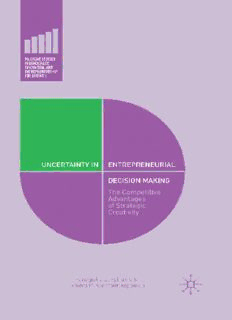
Uncertainty in Entrepreneurial Decision Making: The Competitive Advantages of Strategic Creativity PDF
Preview Uncertainty in Entrepreneurial Decision Making: The Competitive Advantages of Strategic Creativity
PalgraveStudiesinDemocracy,Innovation,and EntrepreneurshipforGrowth SeriesEditor:EliasG.Carayannis The central theme of this series is to explore why some areas grow and others stagnate, and to measure the effects and implications in a trans-disciplinary con- text that takes both historical evolution and geographical location into account. In other words, when, how, and why does the nature and dynamics of a politi- cal regime inform and shape the drivers of growth and especially innovation and entrepreneurship?Inthissocioeconomicandsocio-technicalcontext,howcouldwe bestachievegrowth,financiallyandenvironmentally? Thisseriesaimstoaddresssuchissuesas: ● Howdoestechnologicaladvanceoccur,andwhatarethestrategicprocessesand institutionsinvolved? ● How are new businesses created? To what extent is intellectual property pro- tected? ● Whichculturalcharacteristicsservetopromoteorimpedeinnovation?Inwhat waysiswealthdistributedorconcentrated? Theseareamongthekeyquestionsframingpolicyandstrategicdecisionmakingat firm,industry,national,andregionallevels. A primary feature of the series is to consider the dynamics of innovation and entrepreneurshipinthecontextofglobalization,withparticularrespecttoemerging markets,suchasChina,India,Russia,andLatinAmerica.(Forexample,whatare theimplicationsofChina’srapidtransitionfromprovidinglow-costmanufacturing andservicestobecominganinnovationpowerhouse?Howdotheperspectivesof historyandgeographyexplainthisphenomenon?) Contributions from researchers in a wide variety of fields will connect and relate therelationshipsandinterdependenciesamong(1)innovation,(2)politicalregime, and (3) economic and social development. We will consider whether innovation isdemonstrateddifferentlyacrosssectors(e.g.,health,education,technology)and disciplines (e.g., social sciences, physical sciences), with an emphasis on discover- ingemergingpatterns,factors,triggers,catalysts,andacceleratorstoinnovationand theirimpactonfutureresearch,practice,andpolicy. Thisserieswilldelveintowhatarethesustainableandsufficientgrowthmechanisms fortheforeseeablefuturefordeveloped,knowledge-basedeconomiesandsocieties (such as the European Union and the United States) in the context of multiple, concurrent,andinterconnected“tipping-point”effectswithshort-(MENA)aswell aslong-term(China,India)effectsfromageostrategic,geoeconomic,geopolitical, andgeotechnologicalsetofperspectives. This conceptualization lies at the heart of the series and offers to explore the correlationbetweendemocracy,innovation,andgrowth. BooksAppearinginThisSeries: UnpackingOpenInnovation:HighlightsfromaCo-EvolutionaryInquiry ManlioDelGiudice,EliasG.Carayannis,andMariaRosariaDellaPeruta TheEntrepreneurialRiseinSoutheastAsia:TheQuadrupleHelixInfluenceonTech- nologicalInnovation StavrosSindakisandChristianWalter Uncertainty in Entrepreneurial Decision Making: The Competitive Advantages of StrategicCreativity PanagiotisE.PetrakisandDimitraP.Konstantakopoulou Uncertainty in Entrepreneurial Decision Making The Competitive Advantages of Strategic Creativity Panagiotis E. Petrakis and Dimitra P. Konstantakopoulou UNCERTAINTYINENTREPRENEURIALDECISIONMAKING Copyright©PanagiotisE.Petrakis&Dimitra P.Konstantakopoulou,2015. Softcoverreprintofthehardcover1stedition2015978-1-137-46078-3 Allrightsreserved. Firstpublishedin2015by PALGRAVEMACMILLAN® intheUnitedStates—adivisionofSt.Martin’sPressLLC, 175FifthAvenue,NewYork,NY10010. WherethisbookisdistributedintheUK,Europeandtherestofthe World,thisisbyPalgraveMacmillan,adivisionofMacmillanPublishers Limited,registeredinEngland,companynumber785998,of Houndmills,Basingstoke,HampshireRG216XS. PalgraveMacmillanistheglobalacademicimprintoftheabove companiesandhascompaniesandrepresentativesthroughouttheworld. Palgrave®andMacmillan®areregisteredtrademarksintheUnited States,theUnitedKingdom,Europeandothercountries. ISBN978-1-349-68989-7 ISBN978-1-137-46079-0(eBook) DOI10.1057/9781137460790 LibraryofCongressCataloging-in-PublicationData Petrakis,PanagiotisE.,1953– Uncertaintyinentrepreneurialdecisionmaking:thecompetitive advantagesofstrategiccreativity/PanagiotisE.Petrakis& DimitraP.Konstantakopoulou. pages cm.—(Palgravestudiesindemocracy,innovation,and entrepreneurshipforgrowth) Includesbibliographicalreferencesandindex. 1. Entrepreneurship. 2. Uncertainty. 3. Decisionmaking. 4. Strategicplanning. I. Konstantakopoulou,DimitraP., 1975– II. Title. HB615.P39472015 658.4(cid:2)03—dc23 2015001640 AcataloguerecordofthebookisavailablefromtheBritishLibrary. DesignbyIntegraSoftwareServices Firstedition:July2015 10 9 8 7 6 5 4 3 2 1 Contents ListofTablesandFigures vii Introduction ix Part I TheStateoftheFuture 1 TheUnknownFuture 3 2 TheInevitableTrends:ReturnsandUncertainty 17 3 HowWilltheFutureBeShaped? 33 Part II FutureEntrepreneurshipandCompetitive Advantage 4 EntrepreneurshipOpportunitiesandFuture CompetitiveAdvantage 45 5 EntrepreneurshipunderUncertainty 59 6 EntrepreneurialBehaviorandForesight 75 7 EntrepreneurialDecisionsunderUncertainty 95 8 StrategyforFutureCompetitiveAdvantage 111 Part III CreativeStrategicScenarioThinking (CSST) 9 FuturingandVisioningasStrategicInstrumentsfor PredictingtheFuture 129 10 StrategicScenarioThinking 141 11 ScenariosunderHighUncertaintyandLowReturns 155 vi Contents 12 CreativeStrategicScenarioThinkingunderHigh UncertaintyandLowNominalReturns 167 Notes 185 Bibliography 187 Index 213 Tables and Figures Tables 7.1 Connectionsamongtheoriesandtheroleoftime 98 7.2 Decisionmakingunderconditionsofuncertainty, accordingtorationalprospecttheory 107 Figures 1.1 Futureanalysis 4 1.2 Threetypesofchanges 15 2.1 IncreaseinuncertaintyintheUnitedStates (USUncertaintyIndex) 30 12.1 Decisionmakingusingtraditionalevaluation methodsunderlowuncertainty 182 12.2 Decisionmakingthroughcreativestrategic scenariothinkingunderhighuncertaintyandlow nominalreturn 183 Introduction The dominant issue in the analysis of entrepreneurship is the study of the conditions of its development. The development of entrepreneurship is associated with the future, in turn asso- ciated with uncertainty, which is not necessarily quantified as measurablerisk. Thisbook,UncertaintyinEntrepreneurialDecisionMaking:The CompetitiveAdvantageofStrategicCreativity,investigatesthecon- ditions for evaluating future business decision making under high uncertainty. Of course, future development is an extension of the past and present. Some of the factors that determine future change are already visible and depend on the time horizon of the analysis. However, the future develops in an unknown manner and follows differentpathsdependingonthesocial,economic,andtechnolog- ical changes that occur. Future surprises, and specifically their size andnature,determinethedegreeofuncertaintythataffectsfuture entrepreneurship. Researchersfocusmuchoftheirattentiononlong-termgrowth and development prospects and are especially concerned with assessing optimistic or pessimistic views on average investment returns.Developedcountriesarecurrentlycharacterizedby(a)the useofheavymonetarypolicymethodstomaintaingrowthratesand employment levels of the productive workforce since the 1970s, and especially to avert the great financial crisis of 2008, (b) the possibility of secular stagnation, (c) the prevailing of global pro- ductivestructuralrearrangements,alongwithstructuralchanges,in theageofpopulationsandtechnologicaldevelopments,andfinally, (d) an already high level of development achieved by the devel- opedeconomies.Thus,itisfoundthattheworldisenteringalong period of low average nominal returns on entrepreneurial invest- ments. Additionally, serious incidents of uncertainty periodically occurandendangerthedevelopmentofentrepreneurship. Thus, a situation of low nominal return and high uncertainty is formed. Under those circumstances, even low uncertainty causes significantfluctuationinrealratesofreturns. x Introduction Entrepreneurial attempts will always exist (even with low entrepreneurialreturns),becausetheincentivesfortheiractivation arecomplex. Givenprevailinglowratesofreturn,traditionalinvestmentanal- ysis (net present value—NPV) suggests that all investments that offer a positive return should be accepted. But the existence of uncertainty, even intense uncertainty, suggests the opposite since uncertainty decreases the reliability of traditional evaluation meth- ods (e.g., net present value or others that rely largely on rational choice). Certainly, the existence of low nominal return and high fre- quency uncertainty (LNR/HFU) conditions (such as forecast for the next three years in Europe), although expected to provide a common reference point for the entire economy, does not nec- essarily exert a universal effect. Innovative enterprises normally have high performance. Moreover, there will always be innovative entrepreneurial conditions that create oligopolistic or monopolis- tic market conditions and thus allow higher returns. For exam- ple, specific regions or entrepreneurs in developing economies may remain highly profitable destinations for venture capital. Consequently, new approaches are required for evaluating alter- native future entrepreneurship opportunities, because traditional approaches cannot meet the requirements of the LNR/HFU environment.Therefore,differentevaluationtoolsareneeded. This book proposes creative scenario thinking as a tool for the developmentoffuturecompetitiveadvantage. We wish to thank the following people who contributed to the completionof this book. In particular,a special thank-you goes to Mr. P. C. Kostis for his cooperation on Chapters 1, 3, and 9; to Mrs. K. I. Kafka for her cooperation on Chapters 2, 4, and 8; to Mr. H. V. Basdekis for his cooperation to Chapters 5, 6, and 7; andtoMr.D.G.ValsamisforhiscooperationonChapters10,11, and12(allresearchersintheUniversityofAthens).Ofcourse,final responsibilityforthepresentationofthisbooklieswiththeauthors. Our scientific work could not have been completed without the help of our colleagues at the University of Athens, particularly Mrs.E.Gkiouli,whocontributedsignificantlytothedevelopment ofthisscientificproject. P.E.Petrakis D.P.Konstantakopoulou
Description: